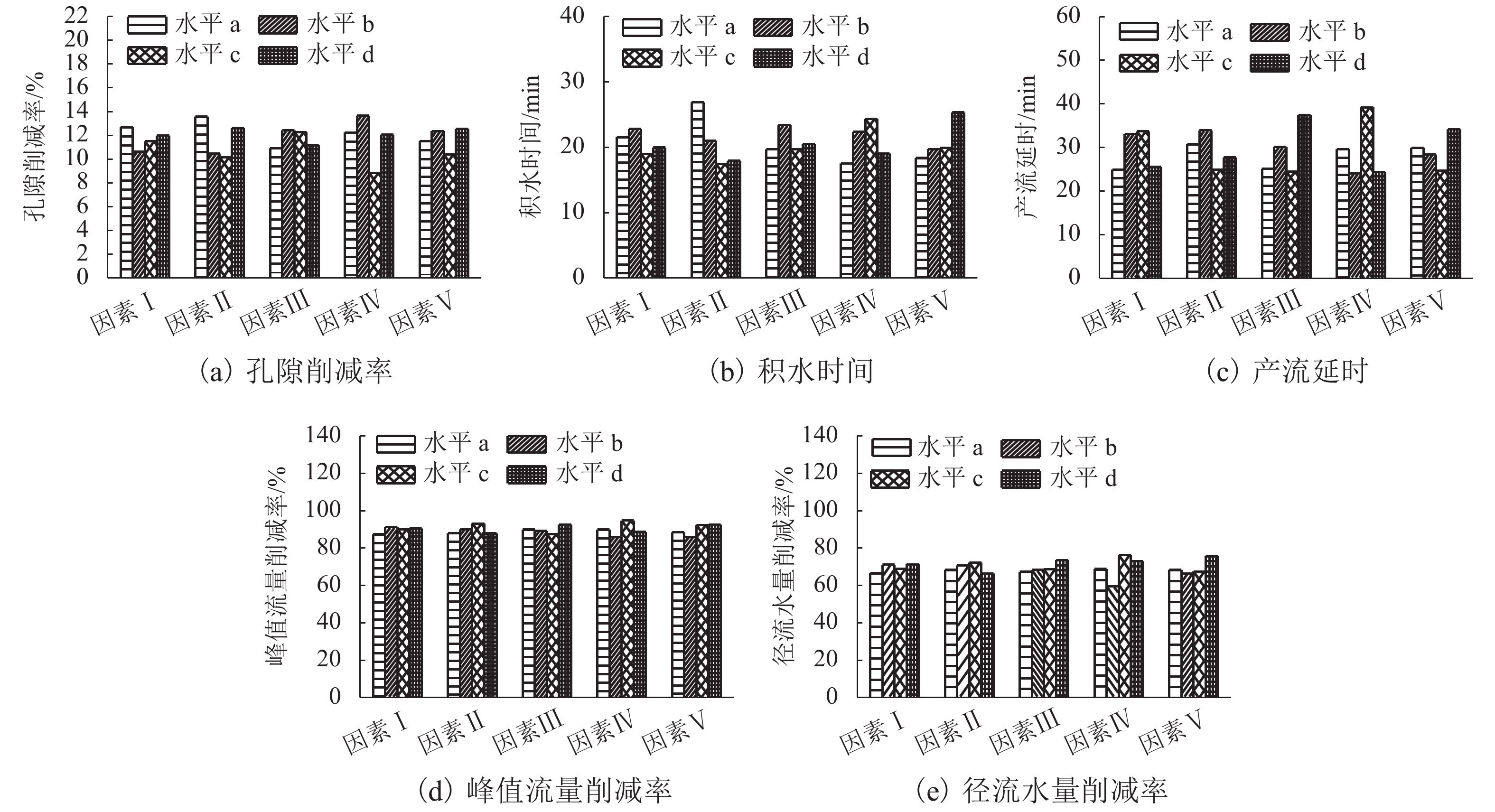Influence of Biologic Retention Zone Structure on Its Infiltration-Storage
-
摘要: 为了研究生物滞留带构造参数及组合方式对其渗蓄效果的影响,提出了判定生物滞留带渗蓄效果的评价指标,并对16组不同构造的生物滞留带开展模拟降雨径流正交试验,研究了种植土和填料层成分及含量、透水土工布位置、砂层颗粒级配和构造厚度对生物滞留带渗蓄效果的影响. 研究结果表明:影响生物滞留带渗蓄效应程度大小的排序为:砂层级配>填料层成分和含量>结构层厚度>土工布位置>种植土成分和含量;生物滞留带最佳组合形式从上至下依次为:20 cm厚种植土,35 cm厚填料层(其中珍珠岩、蛭石、土壤和砂的体积占比为10%、5%、10%和75%),10 cm厚砂层(其中砂层颗粒级配为0~0.5 mm占15%、0.5~0.7 mm占40%、0.7~1.0 mm占30%、1.0~2.0 mm占15%),20 cm厚砾石层以及不设置透水土工布.Abstract: To investigate the influence of structural parameters and combination mode of the biologic retention zone on its infiltration-storage effect, the evaluation index for determining the infiltration-storage effect of biologic retention zone was put forward, and the 16 groups orthogonal experiments under the different conditions of the biological retention zone structural layer parameters were carried out. The composition and content of the planting soil and packing layer, the position of the geotextile, the grain gradation of the sand layer, and the thickness of structure layer on infiltration-storage effect of the biological retention zone were studied quantitatively. The results show that the degree of effect which varies from large to small is the grain gradation of sand layer, the composition and content of packing layer, the structural thickness, the position of geotextile, the composition and content of planting soil. The optimal structure of the biological retention zone from top to bottom is: 20 cm thick planting soil, 35 cm thick filler layer (the volume fraction are 10% perlite, 5% vermiculite, 10% loam, and 75% sand), 10 cm thick sand (0−0.5 mm accounting for 15%, 0.5−0.7 mm accounting for 40%, 0.7−1.0 mm accounting for 30%, and 1.0−2.0 mm accounting for 15%), 20 cm thick gravel layer, and without the geotextile.
-
Key words:
- urban road /
- biological retention zone /
- runoff /
- infiltration-storage effect /
- orthogonal experiment
-
表 1 试验工况
Table 1. Test conditions
试验
工况水平 结构厚度比(砾石层∶砂层∶填料
层∶种植土)砂层各粒径体积比
((1.0~2.0 mm]∶
(0.7~1.0 mm]∶
(0.5~0.7 mm]∶
[0~0.5 mm])透水土
工布位置填料层体积比
(珍珠岩∶蛭石∶
土壤∶砂)种植种植土层体积比
(黏土∶草炭∶砂)Ⅰ Ⅱ Ⅲ Ⅳ Ⅴ 1 a a a a a 20∶10∶20∶35 25∶40∶30∶5 砂层~砾石层 10∶15∶20∶55 5∶30∶65 2 a b b b b 20∶10∶25∶30 20∶35∶35∶10 填料层~砂层 10∶10∶15∶65 5∶30∶65 3 a c c c c 20∶10∶30∶25 15∶30∶40∶15 包裹排水管 10∶5∶10∶75 5∶30∶65 4 a d d d d 20∶10∶35∶20 10∶25∶45∶20 无 10∶0∶5∶85 5∶30∶65 5 b a b c d 20∶10∶35∶20 15∶30∶40∶15 填料层~砂层 10∶15∶20∶55 5∶25∶70 6 b b a d c 20∶10∶30∶25 10∶25∶45∶20 砂层~砾石层 10∶10∶15∶65 5∶25∶70 7 b c d a b 20∶10∶25∶30 25∶40∶30∶5 无 10∶5∶10∶75 5∶25∶70 8 b d c b a 20∶10∶20∶35 20∶35∶35∶10 包裹排水管 10∶0∶5∶85 5∶25∶70 9 c a c d b 20∶10∶25∶30 10∶25∶45∶20 包裹排水管 10∶15∶20∶55 5∶20∶75 10 c b d c a 20∶10∶20∶35 15∶30∶40∶15 无 10∶10∶15∶65 5∶20∶75 11 c c a b d 20∶10∶35∶20 20∶35∶35∶10 砂层~砾石层 10∶5∶10∶75 5∶20∶75 12 c d b a c 20∶10∶30∶25 25∶40∶30∶5 填料层~砂层 10∶0∶5∶85 5∶20∶75 13 d a d b c 20∶10∶30∶25 20∶35∶35∶10 无 10∶15∶20∶55 5∶15∶80 14 d b c a d 20∶10∶35∶20 25∶40∶30∶5 包裹排水管 10∶10∶15∶65 5∶15∶80 15 d c b d a 20∶10∶20∶35 10∶25∶45∶20 填料层~砂层 10∶5∶10∶75 5∶15∶80 16 d d a c b 20∶10∶25∶30 15∶30∶40∶15 砂层~砾石层 10∶0∶5∶85 5∶15∶80 表 2 生物滞留带渗蓄效果评价指标
Table 2. Evaluation index of the infiltration effect of biological retention zone
序号 评价指标 定义 计算公式 备注 1 径流水量
削减率降雨径流总量和生物滞留带底部穿孔管出水总量差值占降雨径流总量的百分比,忽略蒸发及植物蒸腾,非渗透型生物滞留带无下渗量 RW = (Win − Wout)/Win × 100% Win为降雨径流总量;
Wout为出水总量2 峰值流量
削减率入流流量与出流流量峰值差占入流流量百分比 RQ = (Qin − Qout)/Qin × 100% Qin为路面径流量;
Qout为排水管峰值流量3 产流延时 降雨开始和排水管出水时刻之差 tr = Tstart − Tout Tstart为开始降雨时间;
Tout为排水管出流时间4 积水时间 储水层开始储水到全部下渗经历的时间 tR = tstart − tend tstart为储水层开始
储水时刻;
tend为结束储水时刻5 孔隙
削减率储水前后生物滞留带沉降量差值与储水前生物滞留带厚度的比值 RH = (Hstart − Hend)/ Hstart × 100% Hstart为雨前土体高度;
Hend为雨后土体高度
两者差值即为沉降值表 3 各工况渗蓄效果评价指标计算结果
Table 3. Calculation results of evaluation index for seepage effect of various conditions
试验工况 孔隙削减率/% 积水时间/min 产流延时/min 峰值流量削减率/% 径流水量削减率/% 1 14.12 20.74 23.17 84.52 61.64 2 14.78 24.70 24.07 79.22 53.53 3 7.51 19.64 20.99 95.74 73.36 4 14.27 21.08 31.44 89.82 77.41 5 9.88 18.36 28.74 89.74 69.85 6 11.33 14.88 17.62 90.78 75.51 7 12.72 20.23 30.42 91.21 77.23 8 13.98 26.29 25.19 90.09 62.53 9 12.35 14.40 28.62 90.28 61.97 10 12.00 20.54 24.63 92.41 65.82 11 6.69 19.91 56.96 96.72 80.11 12 14.95 21.04 24.42 80.82 67.29 13 13.89 17.90 21.98 81.62 56.23 14 9.78 14.73 36.17 93.47 74.09 15 7.65 19.14 24.02 92.94 71.81 16 11.22 39.40 50.09 96.38 81.97 表 4 各指标最优组合方案统计
Table 4. Optimal combination schemes for each index
评价指标 最优水平组合 Ⅰ Ⅱ Ⅲ Ⅳ Ⅴ 径流水量削减率 d c d c d 峰值流量削减率 b c d c d 产流延时 c b d c d 积水时间 c c a a a 孔隙削减率 b c a c c 最优方案 c c d c d 表 5 各指标下各因素的水平均值和极差
Table 5. Horizontal mean and extreme difference of the factors under each index
影响因素 参数 峰值流量削减率/% 径流水量削减率/% 孔隙削减率/% 积水时间/min 产流延时/min 因素 Ⅰ
(种植土成分和含量)水平 a 87.33 66.48 12.67 21.54 24.91 水平 b 91.10 71.03 10.64 22.79 33.06 水平 c 90.06 68.80 11.50 18.97 33.66 水平 d 90.46 71.28 11.98 19.94 25.49 极差 3.78 4.80 2.03 3.82 8.74 权重 0.127 0.111 0.145 0.125 0.158 归一化处理WⅠ WⅠ =(0.127+0.111+0.145+0.125+0.158)/5=0.133 因素 Ⅱ
(填料层成分和含量)水平 a 87.95 68.36 13.57 26.87 30.72 水平 b 90.02 70.67 10.46 21.00 33.87 水平 c 93.10 72.20 10.15 17.45 24.85 水平 d 87.87 66.36 12.60 17.94 27.69 极差 5.23 5.83 3.41 9.42 9.01 权重 0.177 0.135 0.244 0.307 0.163 归一化处理WⅡ WⅡ =(0.177+0.135+0.244+0.307+0.163)/5=0.205 因素 Ⅲ
(土工布位置)水平 a 89.90 67.28 10.91 19.69 25.14 水平 b 89.16 68.25 12.42 23.35 30.10 水平 c 87.35 68.53 12.27 19.70 24.45 水平 d 92.53 73.53 11.18 20.50 37.44 极差 5.18 6.26 1.51 3.65 12.98 权重 0.175 0.145 0.108 0.119 0.234 归一化处理WⅢ WⅢ =(0.175+0.145+0.108+0.119 +0.234)/5=0.156 因素 Ⅳ
(砂层级配)水平 a 89.87 68.73 12.24 17.52 29.59 水平 b 85.84 59.53 13.66 22.36 23.97 水平 c 94.65 76.32 8.83 24.33 39.19 水平 d 88.59 73.00 12.05 19.04 24.38 极差 8.81 16.79 4.84 6.80 15.23 权重 0.297 0.390 0.346 0.222 0.275 归一化处理WⅣ WⅣ =(0.297+0.390+0.346+0.222 +0.275)/5=0.306 因素 Ⅴ
(结构层厚度)水平 a 88.41 68.37 11.51 18.36 29.93 水平 b 85.82 66.19 12.35 19.71 28.35 水平 c 92.26 67.42 10.37 19.87 24.70 水平 d 92.45 75.61 12.55 25.31 34.14 极差 6.64 9.42 2.18 6.95 9.44 权重 0.224 0.218 0.156 0.227 0.170 归一化处理WⅤ WⅤ =(0.224+0.218 +0.156+0.227+0.170)/5=0.199 -
LIU J, SAMPLE D J, BELL C, et al. Review and research needs of bioretention used for the treatment of urban stormwater[J]. Water, 2014, 6(4): 1069-1099. doi: 10.3390/w6041069 李海燕,罗艳红,张悦. LID措施在道路雨水利用工程中的应用[J]. 节水灌溉,2013,11: 44-49. doi: 10.3969/j.issn.1007-4929.2013.02.012LI Haiyan, LUO Yanhong, ZHANG Yue. Application of LID in road runoff utilization engineering[J]. Water Saving Irrigation, 2013, 11: 44-49. doi: 10.3969/j.issn.1007-4929.2013.02.012 陶俊. 海绵城市理念在姚江新城道路设计中的实践[J]. 城市道桥与防洪,2017,7: 87-91.TAO Jun. Practice of sponge city concept in road design of Yaojiang new city[J]. Urban Roads Bridges & Flood Control, 2017, 7: 87-91. 许萍,司帅,张建强,等. 深圳光明新区透水沥青道路与滞留带对径流水质水量控制效果研究[J]. 给水排水,2015,41(11): 64-69. doi: 10.3969/j.issn.1002-8471.2015.11.015XU Ping, SI Shuai, ZHANG Jianqiang, et al. Study on control effects of permeable asphalt road and road retention on water quality and quantity of runoff[J]. Water & Wastewater Engineering, 2015, 41(11): 64-69. doi: 10.3969/j.issn.1002-8471.2015.11.015 罗瑜. 海绵城市道路低影响设计经验总结[J]. 低碳世界,2017,10: 233-234. doi: 10.3969/j.issn.2095-2066.2017.15.149LUO Yu. Summary of experience in low impact design of spongy city road[J]. Low Carbon World, 2017, 10: 233-234. doi: 10.3969/j.issn.2095-2066.2017.15.149 LUCKE T, NICHOLS P W B. The pollution removal and stormwater reduction performance of street-side bioretention basins after ten years in operation[J]. Science of the Total Environment, 2015, 536: 784-792. doi: 10.1016/j.scitotenv.2015.07.142 LI M H, SWAPP M, KIM M H, et al. Comparing bioretention designs with and without an internal water storage layer for treating highway runoff[J]. Water Environment Research, 2014, 86(5): 387-397. doi: 10.2175/106143013X13789303501920 LI L, DAVIS A P. Urban stormwater runoff nitrogen composition and fate in bioretention systems[J]. Environmental Science & Technology, 2014, 48(6): 3403-3410. TIAN J, YI S, IMHOFF P T, et al. Biochar-amended media for enhanced nutrient removal in stormwater facilities[C]//World Environmental and Water Resources Congress 2014: Water without Borders. Oregon: ASCE, 2014: 197-208. 杨世蜀,王海洋. 人工生物蓄水过滤系统对雨水的滞留与过滤功效[J]. 环境工程学报,2015,9(5): 2259-2264. doi: 10.12030/j.cjee.20150538YANG Shishu, WANG Haiyang. Rainwater retention and filtration effects of artificial biological storage-filtration system[J]. Chinese Journal of Environmental Engineering, 2015, 9(5): 2259-2264. doi: 10.12030/j.cjee.20150538 殷瑞雪,孟莹莹,张书函,等. 生物滞留池的产流规律模拟研究[J]. 水文,2015,35(2): 28-32. doi: 10.3969/j.issn.1000-0852.2015.02.006YIN Ruixue, MENG Yingying, ZHANG Shuhan, et al. Study on runoff of bioretention by model simulation[J]. Journal of China Hydrology, 2015, 35(2): 28-32. doi: 10.3969/j.issn.1000-0852.2015.02.006 MENG Y, WANG H, CHEN J, et al. Modelling hydrology of a single bioretention system with HYDRUS-1D[J]. The Scientific World Journal, 2014: 521047. PAYNE E G I, FLETCHER T D, COOK P L M, et al. Processes and drivers of nitrogen removal in stormwater biofiltration[J]. Critical Reviews in Environmental Science & Technology, 2014, 44(7): 796-846. HUNT W F, LORD W G. Bioretention performance, design, construction, and maintenance[M]. Raleigh: North Carolina Cooperative Extension, 2006: 2-3. BRATIERES K, FLETCHER T D, DELETIC A, et al. Nutrient and sediment removal by stormwater biofilters:a large-scale design optimisation study[J]. Water Research, 2008, 42(14): 3930-3940. doi: 10.1016/j.watres.2008.06.009 -






 下载:
下载:




